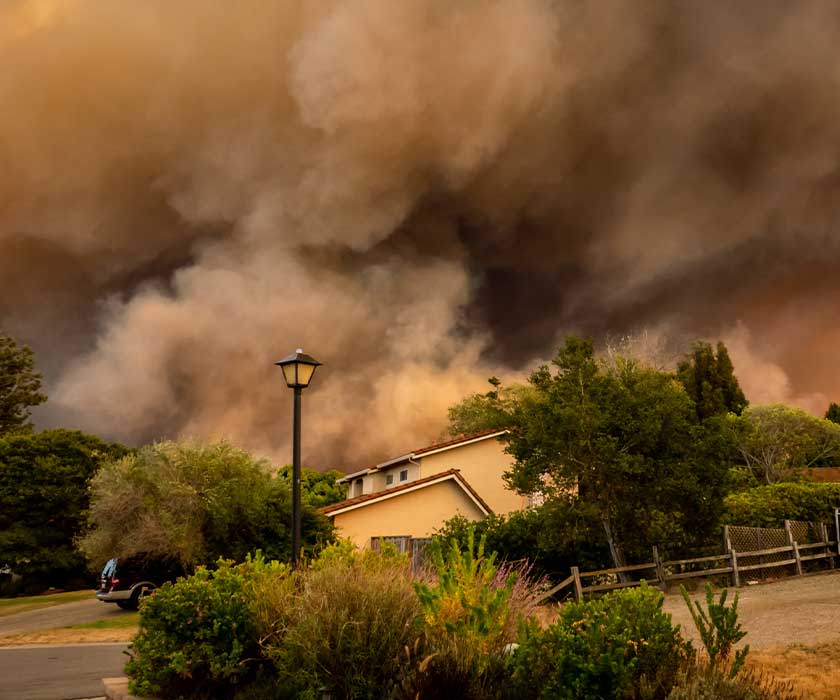How to Improve Indoor Air Quality in Graham, WA Homes During Wildfire Season

To improve indoor air quality during wildfire season in Graham, WA, seal windows and doors, use MERV 13+ HVAC filters, and run HEPA air purifiers continuously. Keep HVAC systems on recirculate mode and avoid indoor pollution sources like candles and gas stoves. Monitor indoor PM2.5 levels and ventilate only when outdoor air quality improves.
How Does Wildfire Smoke Affect Indoor Air Quality?
Wildfire smoke lowers indoor air quality by introducing fine particulate matter (PM2.5), carbon monoxide, and volatile organic compounds (VOCs) into homes. These pollutants enter through open windows, HVAC systems, and small gaps in walls, doors, and vents.
PM2.5 particles are the most dangerous component of wildfire smoke. These microscopic particles, measuring less than 2.5 microns, penetrate deep into the lungs and enter the bloodstream. Exposure to PM2.5 levels above 35 µg/m³ for extended periods increases the risk of asthma attacks, heart disease, and reduced lung function.
Smoke infiltration is influenced by building structure and ventilation. Older homes with poor insulation and unsealed gaps allow more contaminants inside. Homes with central HVAC systems may pull in polluted air unless set to recirculate. Infiltration rates are typically higher in homes with single-pane windows and outdated weather stripping.
Air quality inside homes can degrade rapidly during wildfires. Studies show that indoor PM2.5 levels can reach 70-80% of outdoor concentrations if windows are left open. Even in closed homes, infiltration can cause indoor PM2.5 levels to exceed 50 µg/m³, which is considered unhealthy by the EPA Air Quality Index (AQI).
How Can Homes Be Prepared for Wildfire Season?
Preparing a home for wildfire season involves sealing entry points, upgrading filtration, and creating a clean air space. These steps reduce smoke infiltration and maintain better indoor air quality.
Seal Gaps and Improve Insulation
Homes with unsealed gaps can experience up to 50% more smoke infiltration.Caulking cracks, installing weather stripping, and using door sweeps help block outside air. Upgrading to energy-efficient HVAC systems can further enhance insulation and air quality. Learn more about heating repairs and installation for year-round indoor comfort.
Upgrade to High-Efficiency HVAC Filters
MERV 13+ filters capture at least 85% of PM2.5 particles, making them significantly more effective than standard MERV 8 filters, which only capture around 20%. During wildfire season, filters may need to be changed every two to four weeks due to faster accumulation of particles. If your HVAC system struggles with filtration, consider furnace repairs and installation to improve overall efficiency.
Create a Clean Air Room
Using a HEPA air purifier continuously in a sealed room can reduce PM2.5 levels by up to 90%. Choose a room with few windows and doors for better containment.
Stock Emergency Air Quality Supplies
N95 masks filter at least 95% of airborne particles, providing better protection than cloth or surgical masks. A battery-powered air quality monitor helps track indoor pollution levels when power outages occur.
How Can Indoor Air Quality Be Maintained During a Wildfire?
Keeping indoor air clean during a wildfire requires minimizing smoke entry, filtering pollutants, and avoiding activities that generate indoor emissions.
Keep Windows, Doors, and Vents Closed
Homes with open windows can experience indoor PM2.5 levels reaching 70-80% of outdoor concentrations. Weather stripping and sealing cracks can reduce smoke entry by up to 50%.
Set HVAC Systems to Recirculate and Use MERV 13+ Filters
A MERV 13+ filter captures at least 85% of wildfire smoke particles, while a MERV 8 filter captures only around 20%. Filters should be replaced every two to four weeks during heavy smoke events. If your current system struggles to maintain clean air, explore AC repairs and installation for more efficient air circulation.
Use HEPA Air Purifiers for Particle Filtration
A HEPA filter removes 99.97% of particles as small as 0.3 microns.Running an air purifier continuously in a closed room can reduce PM2.5 levels by up to 90%.
How Can Ventilation and Filtration Be Optimized for Better Air Quality?
Set HVAC Systems to Recirculate Air
Switching to recirculate mode reduces outdoor air infiltration by up to 80%.
Consider Alternative Air Conditioning and Heating Systems
Some heating and cooling systems contribute to indoor pollution. Geothermal heat pumps provide a cleaner, more energy-efficient option by using the earth’s temperature for heating and cooling. Learn more about geothermal heat pump installation and repair for improved indoor air quality.
How Should Homes Be Cleaned After Wildfire Smoke Exposure?
Ventilate the Home When Outdoor Air Improves
Running exhaust fans speeds up air exchange, reducing lingering odors and particles.
Vacuum with a HEPA Filter
A HEPA-filtered vacuum captures at least 99.97% of fine particles.
Replace HVAC and Air Purifier Filters
MERV 13+ HVAC filters should be replaced immediately after heavy smoke exposure. If your system struggles to maintain efficiency after exposure to wildfire smoke, consider professional HVAC service to restore performance.
How Can Homes Reduce Long-Term Exposure to Wildfire Smoke?
Improve Home Sealing to Block Smoke Entry
Caulking cracks and installing weather stripping reduce indoor pollution levels.
Upgrade to a Whole-House Filtration System
A central HVAC system with a MERV 13+ filter can remove 85% or more of PM2.5 particles.
How Can Indoor Air Quality Be Improved Year-Round to Minimize Wildfire Impact?
Run Air Purifiers Daily, Not Just During Wildfires
Using a HEPA air purifier year-round can reduce airborne pollutants by up to 90%.
Replace HVAC Filters Regularly
MERV 13+ filters should be changed every 60-90 days under normal conditions and every 2-4 weeks during wildfire season.
Minimize Everyday Indoor Pollution Sources
Cooking on gas stoves without ventilation can raise PM2.5 levels by over 200%.
Sources
Here are sources with proper anchor text and links for credibility:

Contact HVAC Service Pros For All Your Heating & Air Conditioning Needs!